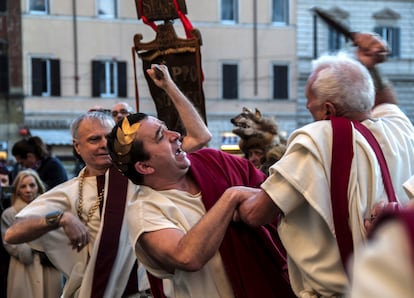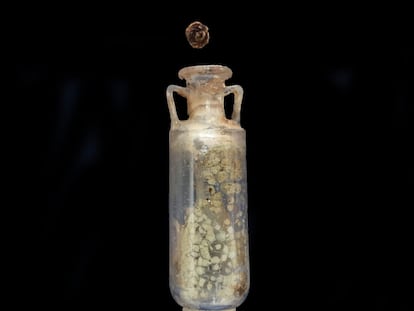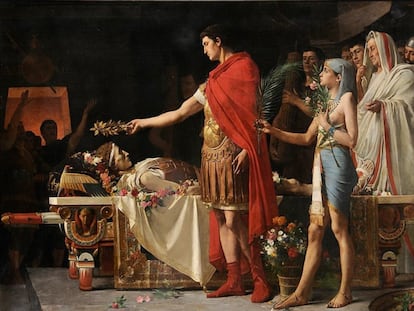Rome opens the site of the most famous political assassination in history
The city has created a new walkway over the archaeological site of Largo di Torre Argentina, a sacred area with four temples where Julius Caesar was killed in 44 BC

The site of the most famous conspiracy and assassination in history — saving the assassination of John F. Kennedy — is now open to the public. This is the square where Roman General Julius Caesar was stabbed 23 times on the morning of the Ides of March. The murder heralded in the end of the late Roman Republic and the beginning of the Roman Empire, which Caesar’s nephew and heir, Caesar Augustus, established after winning the civil war against Mark Antony in the 1st century BC. For centuries, the site of Caesar’s assassination — a defining moment in history that also marked literature, cinema and theater — remained buried in the subsoil of modern Rome. In recent decades, the square had fallen into a state of complete neglect, with a huge colony of cats taking over the area. Now, 2,067 years after Caesar’s murder, it is receiving visitors.
The City Council of Rome has opened a new walkway over the archaeological site of the Largo di Torre Argentina square. The site includes four sacred temples from the Republican era — the little documented period before Augustus took power — which were discovered between 1926-29, when a new neighborhood was being built. When the ruins were found, the Italian state, headed by Benito Mussolini at the time, decided to stop work and preserve them. The strange thing about this site is that while temples preserved from ancient Rome were reused as churches, three of the four in Largo di Torre Argentina were not. “The fact that they have remained like this is almost a miracle,” explains Claudio Parisi, the superintendent of Cultural Heritage in Rome.

The walkway allows visitors to walk through the ruins at the height of the original pavement: about 20 meters below the current street level. “That is one of the great values of the initiative, since it allows us to observe many details, such as the different layers. The different materials also speak of those periods that in some places date from the 2nd century BC to the end of the 1st,” says Parisi.
The four temples formed part of the Theater of Pompey, the scene of the crime. “That was the wall that closed the room of the Theater of Pompey, where the Roman Senate was to meet that day. We are sure that this is the case because sources from the time tell us that there were latrines on the sides. We know that he was assassinated at the foot of the statue of Pompey [once his enemy]. Caesar had received bad omens, but he decided to go anyway, to his misfortune,” explains Parisi. Caesar’s wife, Calpurnia, also reportedly had a nightmare about his death the night before his murder. As Calpurnia was not prone to superstition, it is believed that Caesar took her warnings into account. He is said to have thought twice about meeting the Senate, but continued with his plans regardless. “We have not to fear anything, except fear itself,” Caesar is quoted as saying.
The Curia of Pompey was located at the entrance to the Theater of Pompey and was linked to it by a portico. It was a squarish building, measuring 24 by 27 meters at the base, and it is where the Senate met during the Roman Republic. The site was presided over by a large statue of Pompey (106-48 BC). At the time of Caesar’s assassination, the Curia was being remodeled under the orders of Caesar himself. So on March 15, 44 BC, the general and his senators met in the square where Caesar was killed. Publius Servilius Casca is said to have struck the first blow, grazing Caesar’s neck with a dagger. Then more 30 senators and conspirators, including Marcus Junius Brutus (whose mother was Julius Caesar’s love). This gave rise to the famous quote in the Shakespeare’s play Julius Caesar, when the general says: “Et tu, Brute?” (You too, Brutus?)

The plot to assassinate Caesar was successful, but what happened as a result of the crime was exactly the opposite to what the assassins intended. Rome never regained its freedom and Caesar’s adoptive son, Octavian, established an imperial monarchy under the name of Augustus. Historian Mary Beard explains in her book SPQR that the assassination was the culmination “of a series of key moments and conflicts that led to the dissolution of the free state, a sequence of tipping points that marked the stages in the progressive degeneration of the political process, and a succession of atrocities that lingered in the Roman imagination for centuries.”
Thanks to the new walkway, the Largo di Torre Argentina is now one of the key places to understand the history of Rome. But this initiative was only made possible thanks to funding from the Italian fashion house Bulgari, which dedicated the sum leftover from its restoration of Rome’s historic Spanish Steps to the project. Thanks to this funding, the site has been opened to the public. As for why such an important part of history was not restored earlier, Parisi shrugs and points out that there are around 230 archaeological sites in Rome alone. In a city, where age is measured in centuries, there is not always time or money for everything.
Sign up for our weekly newsletter to get more English-language news coverage from EL PAÍS USA Edition
Tu suscripción se está usando en otro dispositivo
¿Quieres añadir otro usuario a tu suscripción?
Si continúas leyendo en este dispositivo, no se podrá leer en el otro.
FlechaTu suscripción se está usando en otro dispositivo y solo puedes acceder a EL PAÍS desde un dispositivo a la vez.
Si quieres compartir tu cuenta, cambia tu suscripción a la modalidad Premium, así podrás añadir otro usuario. Cada uno accederá con su propia cuenta de email, lo que os permitirá personalizar vuestra experiencia en EL PAÍS.
¿Tienes una suscripción de empresa? Accede aquí para contratar más cuentas.
En el caso de no saber quién está usando tu cuenta, te recomendamos cambiar tu contraseña aquí.
Si decides continuar compartiendo tu cuenta, este mensaje se mostrará en tu dispositivo y en el de la otra persona que está usando tu cuenta de forma indefinida, afectando a tu experiencia de lectura. Puedes consultar aquí los términos y condiciones de la suscripción digital.
More information
Últimas noticias
Aquilino Gonell, former Capitol sergeant: ‘If it hadn’t been for the police, the US would be a dictatorship’
A hybrid building: Soccer pitch, housing, and a shopping mall
Europe urges Trump to respect Greenland following annexation threats
Science seeks keys to human longevity in the genetic mixing of Brazilian supercentenarians
Most viewed
- Alain Aspect, Nobel laureate in physics: ‘Einstein was so smart that he would have had to recognize quantum entanglement’
- Mexico’s missing people crisis casts a shadow over World Cup venue
- Why oil has been at the center of Venezuela-US conflicts for decades
- Alvin Hellerstein, a 92-year-old judge appointed by Bill Clinton, to preside over Maduro’s trial in New York
- Cuba confirms death of 32 of its citizens in the US attack against Venezuela











































